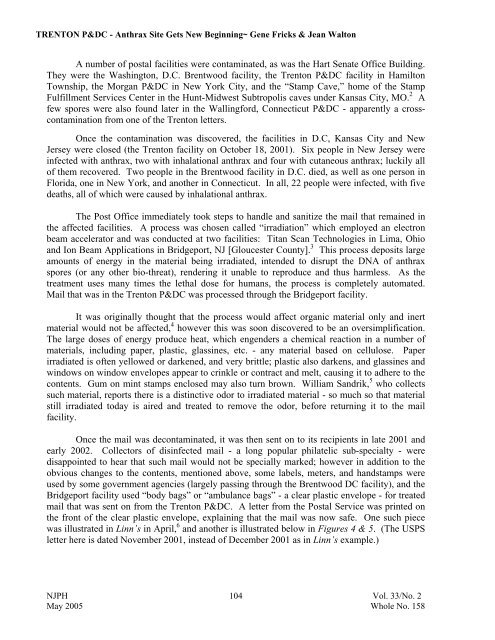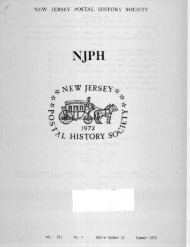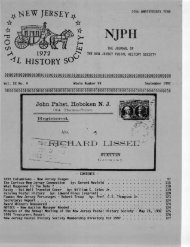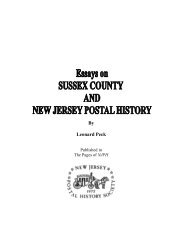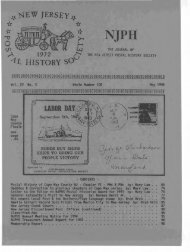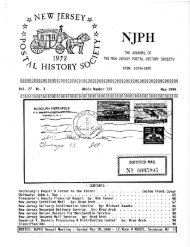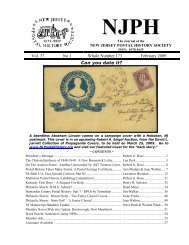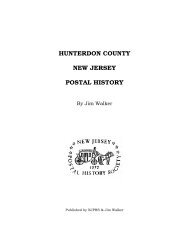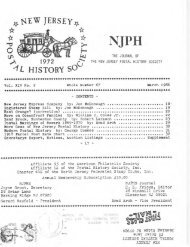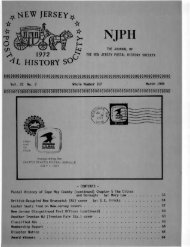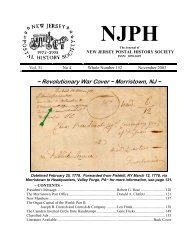Edison First Day Brings High Price! - New Jersey Postal History ...
Edison First Day Brings High Price! - New Jersey Postal History ...
Edison First Day Brings High Price! - New Jersey Postal History ...
You also want an ePaper? Increase the reach of your titles
YUMPU automatically turns print PDFs into web optimized ePapers that Google loves.
TRENTON P&DC - Anthrax Site Gets <strong>New</strong> Beginning~ Gene Fricks & Jean WaltonA number of postal facilities were contaminated, as was the Hart Senate Office Building.They were the Washington, D.C. Brentwood facility, the Trenton P&DC facility in HamiltonTownship, the Morgan P&DC in <strong>New</strong> York City, and the “Stamp Cave,” home of the StampFulfillment Services Center in the Hunt-Midwest Subtropolis caves under Kansas City, MO. 2 Afew spores were also found later in the Wallingford, Connecticut P&DC - apparently a crosscontaminationfrom one of the Trenton letters.Once the contamination was discovered, the facilities in D.C, Kansas City and <strong>New</strong><strong>Jersey</strong> were closed (the Trenton facility on October 18, 2001). Six people in <strong>New</strong> <strong>Jersey</strong> wereinfected with anthrax, two with inhalational anthrax and four with cutaneous anthrax; luckily allof them recovered. Two people in the Brentwood facility in D.C. died, as well as one person inFlorida, one in <strong>New</strong> York, and another in Connecticut. In all, 22 people were infected, with fivedeaths, all of which were caused by inhalational anthrax.The Post Office immediately took steps to handle and sanitize the mail that remained inthe affected facilities. A process was chosen called “irradiation” which employed an electronbeam accelerator and was conducted at two facilities: Titan Scan Technologies in Lima, Ohioand Ion Beam Applications in Bridgeport, NJ [Gloucester County]. 3 This process deposits largeamounts of energy in the material being irradiated, intended to disrupt the DNA of anthraxspores (or any other bio-threat), rendering it unable to reproduce and thus harmless. As thetreatment uses many times the lethal dose for humans, the process is completely automated.Mail that was in the Trenton P&DC was processed through the Bridgeport facility.It was originally thought that the process would affect organic material only and inertmaterial would not be affected, 4 however this was soon discovered to be an oversimplification.The large doses of energy produce heat, which engenders a chemical reaction in a number ofmaterials, including paper, plastic, glassines, etc. - any material based on cellulose. Paperirradiated is often yellowed or darkened, and very brittle; plastic also darkens, and glassines andwindows on window envelopes appear to crinkle or contract and melt, causing it to adhere to thecontents. Gum on mint stamps enclosed may also turn brown. William Sandrik, 5 who collectssuch material, reports there is a distinctive odor to irradiated material - so much so that materialstill irradiated today is aired and treated to remove the odor, before returning it to the mailfacility.Once the mail was decontaminated, it was then sent on to its recipients in late 2001 andearly 2002. Collectors of disinfected mail - a long popular philatelic sub-specialty - weredisappointed to hear that such mail would not be specially marked; however in addition to theobvious changes to the contents, mentioned above, some labels, meters, and handstamps wereused by some government agencies (largely passing through the Brentwood DC facility), and theBridgeport facility used “body bags” or “ambulance bags” - a clear plastic envelope - for treatedmail that was sent on from the Trenton P&DC. A letter from the <strong>Postal</strong> Service was printed onthe front of the clear plastic envelope, explaining that the mail was now safe. One such piecewas illustrated in Linn’s in April, 6 and another is illustrated below in Figures 4 & 5. (The USPSletter here is dated November 2001, instead of December 2001 as in Linn’s example.)NJPH 104Vol. 33/No. 2May 2005 Whole No. 158


